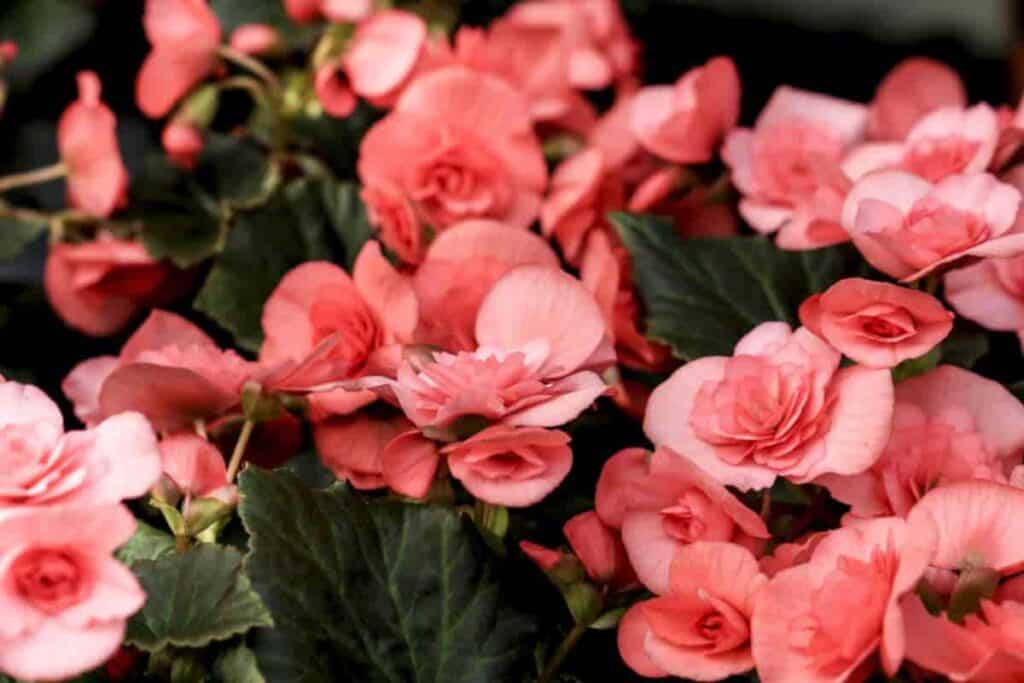Choice winter fare from your greenhouse is the semi-tuberous begonia hybrids with glossy, round, scallop-edged leaves and bountiful blossoms, single or double, in all shades of red, pink, and white. Everybody knows and loves them — they’re one of our most popular winter gift plants, particularly the “Christmas begonia.”
Many want to know exactly what kind of begonias they are? What relationship they have to other types and whether—and how —they can be grown in the home?

First, let’s clear up the confusion. In a very broad sense, there are two types of begonias:
- Fibrous-rooted
- Tuberous-rooted
Among the fibrous-rooted are the familiar wax or rosebud begonias, rhizomatous, rex, hair-leaf, angel-wing, and many others which are usually grown in pots in the house or greenhouse.
Best-known of the tuberous-rooted begonias (in fact, there’s a cult that almost worships them) are the summer-flowering garden varieties that glorify semi-sunny beds and borders. The winter-flowering tuberous begonias also make up a fairly large group.
And there are some semi-tuberous species and hybrids, most of which are popularly called “maple leaf begonias.”
Winter-flowering tuberous begonias are further divided into two types, according to their parentage; hiemalis and cheimantha. Begonia socotrana, a tuberous species discovered growing on an island in the Indian Ocean, is a common parent to both.
But the hiemalis also descends from a tuberous begonia found in the high, cool Andes; and the cheimanthas from semi tuberous B. dregei, from South Africa.
The Largest Blooms
The hiemalis begonias look lustier — more closely approach the floriferous size and magnificence of the summer-blooming. garden types. Flowers, foliage, and plants are larger than the cheiranthus and there is a wider range of brighter-colored double, semi-double, or dogwood-like single flowers.
But the hiemalis are more difficult to grow and propagate, and less likely to adapt to anything less than greenhouse growing conditions. They need cool, humid air (55-58 degrees during the growing season, 50 degrees as they come into flower).
Their sterns are succulent and extremely brittle, also susceptible to mildew and rot. And the buds blast or flowers drop quickly in the warm, dry air of modern homes.
Expect A Dormant Period
Propagating the hiemalis begonias is also tricky. Stem, leaf, or leaf-bud cuttings are taken in midwinter, rooted in sharp sand at 60-65 degrees. The plants themselves are dormant until about March 1, when new growth usually begins to appear from the tuber.
As you can see, these begonias put the home grower’s talents to a severe test. It’s not impossible to save your gift plant, even propagate it. But it’s also not easy.
And yet the hiemalis are among the most beautiful of all begonias. One type, in particular, a strain that originated in Holland—called the Clibran begonias — puts on a magnificent show. The flowers are extra large, extra double, or both.
Colors and tints include some exquisite decorator shades. On a well-grown plant, each leaf is a perfect platter of shining clear green. Glorious is a good word for Begonia hiemalis.
Best For House Plants
One of the most popular varieties has with large, fully double flowers in soft, glowing salmon. Others have three-inch dogwood-like single flowers in rich pink along with dark red varieties.
But the cheimantha begonias, on the other hand, are good prospects for a window sill or home greenhouse growing.
They may be a little less showy; the leaves smaller; the flowers single or semi double in a more restrained range of colors—but they do not necessarily go completely dormant in spring; they have a much longer blooming season, and they are much more adaptable to the warm air and other cultural difficulties in the home.
Miss G Vaughn, of Logan, Iowa, has had happy success with growing cheimantha begonias in her windows—and particularly recommends the new hybrids. She says:
- These bloom more abundantly
- The flowers last longer
- Their color is more intense
- The plants are heavier and sturdier
A Potting Mixture
Here is Miss Vaughn’s recipe for potting soil: four parts loam, four parts leaf mold, two parts sand, two parts dried cow manure, and one-half cup of bone meal per 2.5 gallons of soil mix. Two cups of charcoal in pieces one-fourth inch or smaller will help keep the soil mix light and well-aerated.
Grown fairly warm (60°-72° degrees), in humid air, with full sun in winter, the cheimanthas will bloom with great masses of flowers from November to Easter. After flowering, cut the plants back and watch for new shoots coming up from the roots.
These shoots may be taken off and rooted, or you can root leaves cut with an inch or so of stem left on. Pinch back young plants through the end of August, for bushier growth and fuller flowering.
One final word—both hiemalis and cheimantha begonias are short-day plants and will flower only when they receive light for ten hours or less, per day. Don’t set them where artificial light will reach them after sundown in winter.
44659 by Bernice Brilmayer
